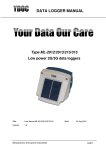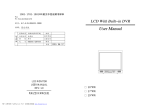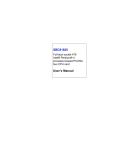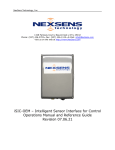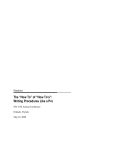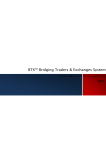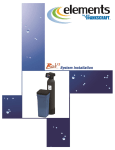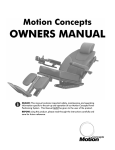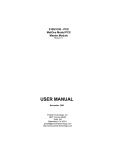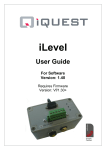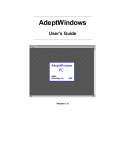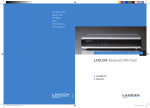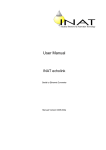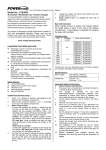Download user manual type ml-2012/13
Transcript
USER MANUAL TYPE ML-2012/13 Type ML-2012/13 Low power GPRS data logger Title : User Manual ML-2012/13 Version : 1.4 Manufacturers of low power instruments Date : 30-Oct-2014 page 1 USER MANUAL TYPE ML-2012/13 WARNING THE FOLLOWING OPERATING INSTRUCTIONS ARE FOR USE BY QUALIFIED PERSONNEL ONLY. TO AVOID DAMAGE OR MALFUNCTION, DO NOT PERFORM ANY OPERATING OTHER THAN THAT CONTAINED IN THIS MANUAL. ANY OPERATOR SHOULD BE SKILLED WITH A TECHNCAL BACKGROUND BEFORE OPERATING THE DEVICE. PREFACE Congratulations! With your purchase of the ML-2012/13 Low Power data logger with GPRS Capabilities. This manual describes the operation and (hardware) installation of the ML-2012/13 Data logger. The chapter Getting Started briefly describes the ML-2012/13 data logger, prepares you to install it, and tells you how to put it into operation. The Chapter Operating Basics covers basic principles of operation of the data logger. The operating interface (menu) and the tutorial examples, rapidly help you to understand how your data logger operates. The Chapter Reference teaches you how to perform specific tasks and provides a complete list of operating tasks and useful background information. The Appendices provide a list with all available options, and other useful information. We recommend you to read this manual carefully before installation of the ML-2012/13. Warranty All YDOC instruments are warranted against defective materials and workmanship. Any questions with respect to the warranty mentioned above should be taken up with your YDOC Distributor. Manufacturers of low power instruments page 2 USER MANUAL TYPE ML-2012/13 Table of Contents 1 Product Description ............................................................................................................................... 5 1.1 Editions ......................................................................................................................................... 6 1.1.1 ML-2012 .................................................................................................................................... 6 1.1.2 ML-2013 .................................................................................................................................... 7 2 Getting started ....................................................................................................................................... 8 2.1 Vibration ........................................................................................................................................ 8 2.1.1 Do’s and Don’ts ........................................................................................................................ 8 2.2 Inserting the SIM-card .................................................................................................................. 8 2.3 Power on for the First time............................................................................................................ 9 2.4 Connect to a PC ........................................................................................................................... 9 3 Operating Basics ................................................................................................................................. 10 3.1 Configuration menu .................................................................................................................... 10 4 Reference ............................................................................................................................................ 16 4.1 Principle of Operation ................................................................................................................. 16 4.1.1 Sample interval ....................................................................................................................... 16 4.1.2 Data logging interval ............................................................................................................... 16 4.1.3 Send Interval ........................................................................................................................... 16 4.1.4 Example .................................................................................................................................. 16 4.2 SDI-12 ......................................................................................................................................... 17 4.2.1 SDI-12 Hardware .................................................................................................................... 17 4.2.2 SDI-12 Wiring ......................................................................................................................... 17 4.2.3 SDI-12 Baud Rate and Frame Format.................................................................................... 18 4.3 RS232 ......................................................................................................................................... 18 4.4 RS485 ......................................................................................................................................... 19 4.5 Analog Inputs (4..20mA) ............................................................................................................. 20 4.5.1 Loop Powered Devices ........................................................................................................... 20 4.6 Analog Differential Inputs (ML-2013 only) .................................................................................. 20 4.6.1 Differential input ports theory of operation.............................................................................. 20 4.6.2 Common mode noise rejection ............................................................................................... 20 4.6.3 Using Load Cells With the ML-2013 ....................................................................................... 20 4.6.4 Bridge of Wheatstone ............................................................................................................. 21 4.6.5 Excitation Output. ................................................................................................................... 21 4.6.6 Analog Differential input 5....................................................................................................... 22 4.6.7 Analog Differential input 6....................................................................................................... 22 4.6.8 Calibration of Differential inputs .............................................................................................. 22 4.6.9 Overall Calibration .................................................................................................................. 22 4.7 Digital inputs ............................................................................................................................... 23 4.7.1 Pull up type ............................................................................................................................. 23 4.7.2 Pull down type ........................................................................................................................ 23 4.8 Coil input ..................................................................................................................................... 23 4.9 Alarming ...................................................................................................................................... 24 4.9.1 Alarming - principal of operation ............................................................................................. 24 4.10 Firmware Upgrade ...................................................................................................................... 25 4.10.1 When to use Firmware upgrades........................................................................................ 25 4.10.2 Firmware upgrade procedure ............................................................................................. 25 4.10.3 Firmware upgrade over the air ........................................................................................... 26 4.10.4 Firmware Driver limitations ................................................................................................. 26 4.10.5 Power Switch Limitations .................................................................................................... 26 4.10.6 Modem ................................................................................................................................ 26 4.10.7 Modem Firmware Upgrade ................................................................................................. 26 4.11 SD-card ....................................................................................................................................... 27 4.11.1 Inserting an SD-card ........................................................................................................... 27 4.12 Data Format ................................................................................................................................ 27 Header: ............................................................................................................................................ 27 Parameter Code: ............................................................................................................................. 28 Manufacturers of low power instruments page 3 USER MANUAL TYPE ML-2012/13 Parameter Name: ............................................................................................................................ 28 Parameter Unit: ................................................................................................................................ 28 4.12.1 D-Records ........................................................................................................................... 28 Parameter Code: ............................................................................................................................. 28 Parameter value: ............................................................................................................................. 28 4.12.2 System-records ................................................................................................................... 29 System Message: ............................................................................................................................ 29 Additional System Message: ........................................................................................................... 29 4.12.3 Data Modifiers ..................................................................................................................... 29 4.13 Transmission of the data log file ................................................................................................. 30 4.14 Input-drivers ................................................................................................................................ 30 4.14.1 Analog sensors ................................................................................................................... 30 4.14.2 Digital Pulse Sensor ........................................................................................................... 31 Example configuration Rain Measurement ...................................................................................... 31 Counter ............................................................................................................................................ 32 Quantity............................................................................................................................................ 32 Rate ................................................................................................................................................. 32 4.15 Power supply .............................................................................................................................. 33 4.15.1 Internal RTC backup battery ............................................................................................... 33 4.15.2 Power consumption & Battery Life ..................................................................................... 33 5 Pin configuration .................................................................................................................................. 34 5.1 ML-2012 ...................................................................................................................................... 34 5.2 ML-2013 ...................................................................................................................................... 35 5.3 Pin Description ............................................................................................................................ 36 5.3.1 Analog Inputs .......................................................................................................................... 36 Analog Input 1 to 4 ........................................................................................................................... 36 Analog Input 5 to 8 (ML-2013 only) ................................................................................................. 36 5.3.2 RS 485 A & B .......................................................................................................................... 36 5.3.3 Power Switch .......................................................................................................................... 36 5.3.4 VBAT + ................................................................................................................................... 36 5.3.5 RX & TX COM 1 & Com 3 ...................................................................................................... 36 5.3.6 SDI-12 Hi ................................................................................................................................ 36 5.3.7 Digital inputs ........................................................................................................................... 36 5.3.8 +3V6 ....................................................................................................................................... 36 5.3.9 Antenna placement and field strength .................................................................................... 37 6 Maintenance and Repair ..................................................................................................................... 37 6.1 RTC Lithium Battery replacement .............................................................................................. 37 6.2 Recalibration ............................................................................................................................... 38 6.3 XRAY .......................................................................................................................................... 38 7 Safety .................................................................................................................................................. 38 7.1 Power supply .............................................................................................................................. 38 7.2 ESD............................................................................................................................................. 38 8 Environment and disposal ................................................................................................................... 39 9 Transport and Storage ........................................................................................................................ 39 10 Specifications ................................................................................................................................... 40 11 EU Declaration of Conformity .......................................................................................................... 41 11.1 ML-2012 ...................................................................................................................................... 41 11.2 ML-2013 ...................................................................................................................................... 42 12 Supported serial transponders......................................................................................................... 43 13 Trouble shooting .............................................................................................................................. 44 Customer Response Form ......................................................................................................................... 45 Manufacturers of low power instruments page 4 USER MANUAL 1 TYPE ML-2012/13 Product Description The ML-2012/13 is designed to retrieve, and store data from various sensors. This data is logged onto the embedded SD-card. Also the stored data can be send from the data logger to any remote computer you like. To use this feature, you need a valid SIM-card. Contact your local telecommunications supplier for more information on the SIM card you will need. The unit accepts various power sources, selectable by the different version types. The user should connect his sensor(s) of preference to the connector board of the device. Captured data can be stored, send, visualized and manipulated in many ways. The ML-2012/13 data logger is a small, ultra low power, high-end data logger with built-in QUAD-band GPRS-modem. This small data logger, is further provided with an internal temperature sensor, 2 GB micro SD-card and an SIM card slot. The logger can be powered by an internal 3.6 Volt Lithium battery that will last for years when the logger is configured in a low-power mode. The ML-2012 data logger can acquire physical signals by 4 current loop inputs, 4 digital inputs The ML2013 data logger can acquire physical signals by 4 current loop inputs, 4 digital inputs and 2 hires amplified differential voltage inputs, which can be used to connect pyranometers or in combination with a stable excitation voltage to connect “Wheatstone resistive bridge sensors” like load cells. The data logger is provided with generic serial port drivers to capture measurements from ASCII, MODBUS/RTU, NMEA or SDI-12 transponders, custom drivers can be developed on request. External sensors/transponders can be powered by the data logger itself, to prevent them to consume power while the data logger is a sleep. The excitation voltage is switched off during sleep as well. Its key features are; - A maximum sample rate of 4 Hz, Recording length up to 2 GB, Four channel 12 bits A/D Convertor for accurate current loop measurements, Two channels 16 bits differential A/D convertor for low voltage measurements (ML-2013 only), Internal micro SD-card with standard FAT-32 File system for easy use with a PC, Various analogue and digital inputs for use with sensors (see specification sheet), Easy configuration by menu’s of embedded menu, Can be used with Windows XP, Vista and W7 Low power / long Battery life (see specification sheet), Embedded GPRS/GSM modem for remote operation, Quad band modem for use all over the world, Alarming by SMS and data delivery by e-Mail, FTP or TCP Internal voltage convertor for supplying 12 VDC power to the connected sensor(s), Stable excitation voltage to power Wheatstone bridged sensors (ML-2013 only), Firmware upgrade over the air for adding new features to your device. Remote configuration over the air, for adjusting your configuration from remote. Manufacturers of low power instruments page 5 USER MANUAL 1.1 TYPE ML-2012/13 Editions The following editions are available: Code ML-2012 ML-2013 ML-2013-PV ML-2013-DC ML-2013-AC ML-2012/13PCB Description Lithium powered data logger in IP65 ABS enclosure with external GSM antenna. Lithium powered data logger in IP67 PA66/GF20 enclosure with integrated GSM antenna. As ML-2013, but with NiMH AA solar charger integrated in cover. As ML-2013, but with 8 .. 30V DC-adapter integrated in cover. As ML-2013, but with 85 .. 265V AC-adapter integrated in cover. As ML-2012/13, but without enclosure and antenna. Remarks Lithium battery not included. Lithium battery not included. NiMH AA batteries not included. To connect the logger to an external VDC source. To connect the logger to an AC power grid. PCB only The data logger will be supplied without pre-mounted cable glands, giving the user the freedom to choose the number and size of the glands them self. Although glass fiber reinforced polyamide is a tough material, drilling gland holes is easy. We recommend removing the PCB before drilling. 1.1.1 ML-2012 The IP65 ABS enclosure of the ML-2012 has a small form factor very suitable to be integrated inside an existing cabinet or the bucket of a rain gauge. 1) 2) 3) 4) 5) SDI-12 and power switch Analog inputs Digital inputs RS232 connector RS485 connector Manufacturers of low power instruments page 6 USER MANUAL 1.1.2 TYPE ML-2012/13 ML-2013 The waterproof IP67 enclosure of the ML-2013 exists out of a casing and cover of glass fiber reinforced polyamide (PA66/GF20) with in between a silicon gasket. The ML-2013 can be used outdoors. 1) Analog inputs 2) RS232 connector 3) Excitation DC/DC convertor 4) Digital inputs 5) SDI-12, power switch and Excitation connector 6) RS485 connector 7) Power switch DC/DC convertor 8) RTC clock battery 9) Power supply connector 10) Fuse 11) Processor 12) Antenna Connector 13) Quad Band Modem 14) USB Connector 15) SIM & SD-card Holder Manufacturers of low power instruments page 7 USER MANUAL 2 TYPE ML-2012/13 Getting started 2.1 Vibration At all times the ML-2012/13 must be protected against vibrations. These vibrations can harm the performance of the data logger. Especially the real time clock can be harmed by long-lasting vibrations 2.1.1 Do’s and Don’ts Do’s - Always provide a dry and clean environment when you open the case of the ML-2012/13, When you open the case, use a Philips screwdriver of 2mm for loosening the screws, Protect the data logger against mechanical stress and vibrations Don’ts - 2.2 Don’t try to use a plain screwdriver for loosening the screws, you will damage the screws, Avoid touching the PCB directly. Inserting the SIM-card The wireless data functions will only work when an activated SIM, with a valid subscription is placed in the ML-2012/13. In the menu the configuration and network settings must also mach to those supplied by the SIM card provider. The pin code of the SIM card must be removed prior to insertion in the data logger. To prevent problems with the SIM card it can be inserted in a mobile phone or GSM data modem. In a Mobile phone or GSM modem the GPRS, SMS and GSM data functionality can be tested. When you have obtained a SIM-card, you can insert it into the SIM-card-holder. Beware: • • • • • • • • • Remove the PIN code (this can be done with the use of a mobile phone), Check the settings of your mobile provider, Check the settings for communicating via FTP / Email / Native TCP, Check the capability of data communication for your service-provider, Make sure the SIM-card is installed correctly, and not upside down. The Oblique side of the card should be visible. (see picture). Installation of the SIM card needs to be done in a clean and dry environment. Avoid contact with the electronic parts around the SIM card. Remove power before changing or inserting a SIM card. The same applies to the SD-card. Manufacturers of low power instruments page 8 USER MANUAL TYPE ML-2012/13 ESD Attention: Although the ML-2012/13 is designed to withstand certain amounts of electrostatic discharge, it is advised to avoid discharged risks. Especially when the housing is open and the electronic parts are exposed. Please do not touch the PCB if you don’t have to. It is strongly recommended to use an earthed wrist-band when touching the PCB. The data logger must be handled with care and never exposed to ESD discharges. When installing a sensor or other wiring, make sure there is no power on both devices. ESD discharges could cause invisible damage. This endangers long term stability and proper operation. 2.3 Power on for the First time In the factory the data logger is programmed with the necessary system information. This information is viewable in the menu. The data logger is ready to use out of the box if the preparations are checked. • • • • SIM card is inserted, SD-card is inserted, Internal battery, or mains power is connected Antenna is connected. Next, connect your sensors, please consult your sensor’s manual for wiring. 2.4 Connect to a PC OS compatibility: The ML-2012/13 can be connected to any PC with USB 2.0 running on Microsoft Windows XP, Windows Vista or Windows 7 Installation procedure for the internal USB adapter for Windows XP is given on the CD. Manufacturers of low power instruments page 9 USER MANUAL 3 TYPE ML-2012/13 Operating Basics 3.1 Configuration menu The ML-2012/13 can be configured by means of terminal emulation software like ‘hyper terminal’. Our own terminal emulation software ‘YDOC-terminal’ can be downloaded from www.your-data-ourcare.com The menu is comprehensive and easy to use. For each different sensor the same approach is used. Below, one example is given to fully understand the operation of the menu. The example takes you through a configuration from start to final stage. Only a few menu-items are used in this example, for a complete overview of all menu-items, see chapter Reference. All menu items use the same approach which is explained in this example. This example explains only the configuration of the firmware, NOT the wiring. For wiring information see the reference. Example: Let’s Configure a ML-2012/13 for operation with the following: - Analog pressure transmitter 4 .. 20mA CT2X conductivity / temperature sensor (INW) FTP data output EMAIL data output Connect the logger to a free USB port on your computer and open with a terminal emulator the virtual COM-port (e.g. COM7) as assigned by Windows to the logger. The first time Windows will ask (if not already installed) for an USB-driver, which can be downloaded from our website as well. When the terminal emulator has opened the COM-port, press: <Ctrl>A<Shift>M<Ctrl>D to enter the configuration menu. You’ll see a screen similar to this: Running Configuration Menu ML-2013 Logger Version 1.6 Build 1 [0] [1] [2] [3] [4] [5] > Run Date & Time >> 2013/07/05 12:58:21 System Information >> 3002389 Configuration Setup >> Brasil Configuration Review Maintenance First we like to give this data logger appropriate identification codes. So, press 3 <Configuration Setup> Manufacturers of low power instruments page 10 USER MANUAL You’ll see this screen: First Rename your Device by Selecting option 1 (General Settings) TYPE ML-2012/13 Configuration Setup [0] [1] [2] [3] [4] [5] [6] [7] [8] [9] [A] [B] [C] [D] [E] > Exit General settings Modem settings NTP Time update Alarm SMS SMS Commands Internal sensors Analog sensors Digital sensor GSM signal sensor Serial port 1 Serial port 2 FTP output TCP output Email output >> YDOC >> >> >> >> >> >> >> >> >> >> >> >> Not Not Not Not Not Not Not Not Not Not Not Not Used Used Used Used Used Used Used Used Used Used Used Used After selecting “General Settings” the screen will look like this: General settings [0] [1] [2] [3] [4] [5] [T] > Exit System Name >> YDOC Data logging interval >> Normal 00:01:00; Alarm Not Used Direct Data output on Data Alarm >> Off Deployment date and time >> 2013/07/05 20:17:42 Time zone >> 2 SD-card test >> Passed < General settings> 1. Press 1 and enter the name of your preference 2. Choose your data logging interval. We used 10 minutes, and NO Alarming. 3. Enter the deployment date & time. This can be a time in the future when logger should start working. We will use the actual date & time to start right away. 4. Exit and save changes. 5. Now, the overall configuration is setup and we proceed with the configuration of the sensors and data output. Next type 7 for Analog sensors Analog sensors [0] [1] [2] [3] [4] [5] [6] [T] > Exit Port 1 Port 2 Port 3 Port 4 Port 5 Port 4 Analog (mA) (mA) (mA) (mA) (mV) (mV) input test >> >> >> >> >> >> >> Not Used Not Used Not Used Not Used Not Used Not Used Passed Choose 1 for Port 1 (mA) and the next screen will appear: Manufacturers of low power instruments page 11 USER MANUAL TYPE ML-2012/13 Analog sensor [0] [1] [2] [3] [4] [5] [6] [7] [8] [9] Exit Name >> Analog Sensor power switch >> Disabled Sample interval >> Normal 00:00:01; Alarm Not Used Port mode >> 4-20 mA Parameter >> Analog 1 Parameter value at 4mA >> 0 units Parameter value at 20mA >> 100 units Determine linear conversion function (2 calibration points) Determine linear offset only (1 calibration point) [R] Remove > 1. Assign a name to the sensor (option 1: Name) 2. Set the power switch to enabled and enter the warm-up time. (the power switch will supply the sensor with 12 Volts, and will be activated the time you specify, before a measurement is taken) 3. Set the sample interval. We use 10 seconds, to quickly check the sensor’s operation. A high range sample interval is no problem for the battery-life, because the sensor will sleep until its data logging interval is reached. So don’t be modest with the sample interval. It gives you great comfort. 4. Set the parameter name. 5. Set both minimum (option 6) and maximum (option 7) values of your sensor at 4mA and at 20mA. If you don’t know those values you could determine the scaling by measuring two calibration points (option 8). Those calibration points don’t have to be at the sensors absolute minimum and maximum, but just two different points within the range of the sensor. (e.g. a measurement at 1m water level and a measurement at 2m water level, while the sensors range is 0..10m) 6. If necessary option 9 can be used to perform an offset correction by measuring a single calibration point. 7. Save and Exit Your screen will look similar to the one underneath: Analog sensor [0] [1] [2] [3] [4] [5] [6] [7] [8] [9] Exit Name >> Upperstream Sensor power switch >> Enabled; Warm up time 00:00:01 Sample interval >> Normal 00:00:10; Alarm Not Used Port mode >> 4-20 mA Parameter >> Water level Parameter value at 4mA >> 0 m Parameter value at 20mA >> 10 m Determine linear conversion function (2 calibration points) Determine linear offset only (1 calibration point) [R] Remove > Manufacturers of low power instruments page 12 USER MANUAL TYPE ML-2012/13 Now we add the CT2X to the system: Go to menu-option A <serial port 1> => RS 485 sensors RS485 Sensors [0] [1] [2] [3] [4] [5] [6] [7] [8] > Choose the INW CT2X (option 2) Exit Generic MODBUS/RTU INW CT2X INW DO INW PT2X type A INW PT2X type B INW PT12 INW TempHion OMC506 Your screen should look like this: INW CT2X sensor [0] [1] [2] [3] [4] [5] [6] [7] [8] [9] Exit Name Port settings Sensor power switch Sample interval Temperature Pressure Conductivity Conductivity nLF Salinity >> >> >> >> >> >> >> >> >> INW CT2X Port 1; 38400 Baud; RS485; Address 1 Disabled Normal 00:00:10; Alarm Not Used Temperature Pressure Not Used Not Used Not Used [R] Remove > Multiple CT2X sensors can be connected to an RS485 bus so you need to specify its address (assuming 1 in this example). This sensor is a multiple parameter sensor, so please specify which you want to log. Attention: Because this is a digital sensor, it takes a little bit more time to measure than an analog sensor. So don’t set the sample interval of digital sensors too short. 1 second is possible, but probably not ¼ sec. Just to be sure we choose 10 sec. Consult the manual of your digital sensor and check the response time. The sample-interval must be larger than the response time of the sensor. Now your sensors are added to the configuration of the ML-2012/13. Manufacturers of low power instruments page 13 USER MANUAL TYPE ML-2012/13 Next thing is the setup of the data outputs. Before that, we have to configure the general modem settings for GPRS operation. Consult your GPRSprovider for the correct local settings. In the reference, a table is included with some international GPRSproviders and their settings. These settings might have been changed. Go to Menu-option 2 <Modem settings> Modem settings [0] [1] [2] [3] [4] [5] [6] [7] [S] [T] > Exit Modem during sleep Frequency selection Provider selection APN Acces point APN User name APN Password Dial-in Autorisation GSM Signal strength APN Login test >> Off >> >> >> >> >> >> internet kpn kpn Off Passed Not Done Now we can setup the FTP, TCP and Email output Therefore go to menu-option: -C Ftp Output. -D Tcp output -E Email output Enter your server-settings. It should look like this: Email settings [0] [1] [2] [3] [4] [5] [6] [7] [8] [9] [A] [R] [T] > Exit Name Send interval Send delay SMTP Server SMTP Port User name Password Originator address Destination address Subject Remove EMAIL test >> >> >> >> >> >> >> >> >> >> Email Normal 01:00:00; Alarm Not Used Not Used smtp.provider.com 25 reh6a01 ******** [email protected] [email protected] YDOC upperstream Beware: Some providers strictly check the Originator address. So make sure this address is valid. >> Not Done Now perform an Email test and check if it is working right. It is strongly recommended to include some internal sensors in the configuration, because of the monitoring of the performance of the data logger itself. Most users like to keep track of the battery-life for example. Manufacturers of low power instruments page 14 USER MANUAL TYPE ML-2012/13 Go To menu-option 6 <internal sensors> Internal sensors [0] [1] [2] [3] [4] [5] [6] [7] [8] [9] [A] [B] [C] [D] [E] [F] Exit Name Sample interval Battery Capacity (mAh) Battery replaced Rest Capacity Rest Power Processor Temperature Voltage Current Max Current Min Current Average Current Free Disk Space Operating Cycle Free Disk Space >> >> >> >> >> >> >> >> >> >> >> >> >> >> >> Internal Normal 00:00:01; Alarm Not Used 17000 Yes Rest Capacity Not Used Processor Temperature Voltage Not Used Not Used Not Used Not Used Not Used Not Used Not Used [R] Remove > A sample interval of 1 second is fine. All internal sensors are very fast. Set the “Battery Replaced” to “Yes”, only when you installed a new battery. Select the items you like to be informed about. See the reference for a complete description of the items. Now your data logger is configured and ready to use. To check your wiring and sensors, you can evaluate the actual values. To see them press: <Ctrl>A<Shift>V<Ctrl>D The result should be like this: 13/07/05 14:22:04 Actual Values ML-2012/13 Logger Version 1.6 Build 1 AIN1 Waterlevel -25 meters MSL TMP Temperature 20.2 C PRS Pressure 0.2 psi RCi Rest Capacity 100 % PTi Processor Temperature 57.4 C Vi Voltage 3.6 V Ci Current 82 mA Manufacturers of low power instruments page 15 USER MANUAL 4 TYPE ML-2012/13 Reference 4.1 Principle of Operation Your ML-2012/13 Data logger is capable of collecting and storing data of multiple sensors. To accomplish this, many tasks are performed. These “tasks” are scheduled and executed on their specified time. The timing of this process is very important and is determined by the internal scheduler. This scheduler keeps track of all the internal states of the various tasks and assigns processor time to the different tasks. Each task is executed on its own interval. To understand more about this, Fist we explain the different intervals. There are three different intervals: 1) Sample Interval 2) Data Log Interval 3) Send Interval 4.1.1 Sample interval The sample interval is the interval on which a sample from the sensor is taken (expected). So, measurements from sensors are done at the sample interval. The sample interval is valid ONLY when the device is in the active state. When the data logger is in sleep-mode, the tasks, triggered by the sample interval will NOT execute. 4.1.2 Data logging interval This interval determines when a data value, obtained by the sample interval-task, is stored onto the SDcard. This type of interval is ALWAYS valid. So, even when the data logger is in sleep-mode, it will wake up when the Data logging Interval has reached its count. 4.1.3 Send Interval The send interval determines the interval on which data is send, via the internal modem. This interval is ALWAYS valid, even if the data logger is in sleep-mode. 4.1.4 Example Let’s evaluate the following settings of the data logger: - Sample Interval: 5 seconds Data Log Interval: 10 minutes Send Interval: 3 hours When the configuration is ready and the user disconnects the USB-Cable; 1. Data logger is switched into sleep-mode, and current draw is reduced to a minimum level. 2. The Sample interval of 5 seconds is discarded, because this interval is only active when the data logger is NOT in sleep-mode. So nothing happens until the Data Log interval has reached his count. (So this happens on 0, 10, 20, 30, 40, 50 minutes every hour) Manufacturers of low power instruments page 16 USER MANUAL TYPE ML-2012/13 3. When the Data Log Interval count has reached his count, the data logger will awake from the sleep mode, and will take a sample and stores the data on the SD-card. When the sample is taken, the data logger goes into sleep-mode again. This is repeated, until the time has matched the Send interval. So, in this example, this is 3 hours. 4. When Data Send interval is reached, the data logger will wake-up, and starts to send the previously collected data (stored on the SD-card) to the server. So, in this example, every 10 minutes a sample is taken, and every 3 hours, 18 samples are send. Note: So, the data logger does not perform any averaging. Even if the sample interval is much faster than the data log interval, only one sample is stored. The use of the sample interval is for evaluating proper behavior of the system, while the USB is connected. Because in that case, the sample interval is valid, and the user can observe the value’s obtained from the sensor in real time. In this case, the user can evaluate these values every 5 seconds. 4.2 SDI-12 The ML-2012/13 is provided with an SDI-12 port. This port is connected to port 2 and is shared with the normal RS232 operation. This means that the user has to select whether he wants to use RS232 or SDI12. When SDI-12 is selected, it acts like a SDI-12 recorder and its specific SDI-12 commands are embedded in the driver of the input-sensor. So the user can easily select his sensor and specify its SDI12-adress. For more information see the description of you SDI-12 sensor. 4.2.1 SDI-12 Hardware The SDI-12 standard is a very commonly used interface-standard in the USA. In Europe, it is rarely used. The signal levels are quite different from those of RS232 and RS485. So, you cannot connect a SDI-12 sensor to a RS232 or RS485 port, it won’t work. The use of convertors between RS232/485 and SDI-12 is discouraged, because of the high pricing of the convertors and the bad performance (see note). 4.2.2 SDI-12 Wiring The SDI-12 electrical interface uses the SDI-12 bus to transmit serial data between SDI-12 data recorders and sensors. The SDI-12 bus is the cable that connects multiple SDI-12 devices. This is a cable with three conductors: 1) a serial data line, 2) a ground line and 3) a 12VDC line Manufacturers of low power instruments page 17 USER MANUAL TYPE ML-2012/13 The wiring length between a sensor and the data-recorder must not exceed 60 meters. The maximum number of sensor connected to a SDI-12 bus is limited to 10. The ML2011 is protected against transients on the SDI-12 bus. 4.2.3 SDI-12 Baud Rate and Frame Format The baud rate for SDI-12 is 1200. Frame format is as follows: 1 start bit 7 data bits, least significant bit transmitted first 1 parity bit, even parity 1 stop bit Note: SDI-12 is a half-duplex protocol, so the data-recorder has to switch between transmitting and receiving. A convertor from RS232 SDI-12, must perform this task. However, it is not aware of the exact timing of the protocol. Therefore it uses fixed (or configurable) delays to switch between Tx and Rx. After each byte send by the convertor, it waits, during the fixed delay, for another character, and if it doesn’t arrive, it switches to Rx. The intelligence needed to perform these tasks is mostly done by a microcontroller inside the convertor, that’s the main reason for its high pricing. This method is doing the job for most cases, but it is not as good as a real SDI-12 port. The real SDI-12 port is aware of the exact protocol-timings and after the last character it switches to RX-mode immediately, without the delay. Therefore no replies are missing. Your ML-2012/13 has a true SDI-12 port. For more information on the SDI-12 protocol: see www.sdi-12.org 4.3 RS232 Your ML-2012/13 comes with 2 RS232 ports, capable of baud rates of up to 115200 bps (230400 bps on request). The ports are: port 1 and port 2. Port one is shared with the RS-485 port and port 2 is shared with the SDI-12 port. The user can choose any combination he likes, as long as he is using only one at a time. (e.g. you cannot share RS232 and RS485 one the same port). If a user needs RS232 and RS485 simultaneously, he needs to setup Port 2 also. RS232 is a widely spread interface standard, which uses 3 wires (minimum) for data communication. It is a so called asymmetric interface, that uses one wire for Tx, one for Rx and one for ground. It is called asymmetrical, because it uses only one wire per signal. Therefore it’s susceptible for interference, and hence, the maximum cable length is limited to 15meters. Please keep in mind these limitation when you design your system. RS232 is not a bus system, and therefore it is only allowed for one device to be connected to a RS232 port. So, the maximum number of serial devices to connect to your ML-2012/13 is 2. RS232 sensors should be connected to the data logger with their signals crossed. That is Rx Tx. We strongly recommend using RS485 instead of RS232, when cable length exceeds the 15m. Manufacturers of low power instruments page 18 USER MANUAL 4.4 TYPE ML-2012/13 RS485 RS485 is a serial bus-system, which uses 3 wires for its communication. It uses a “differential balanced line”, which can span relatively large distances (up to 4000 feet (1200 m)). A rule of thumb is that the 8 speed in bit/s multiplied by the length in meters should not exceed 10 . Thus a 50 meter cable should not signal faster than 2 Mbit/s. Instead of RS232, RS485 is capable of communicating with more than one device. After all, it is a bussystem. RS485 sensors are called “slaves” and must have their unique address. The ML-2012/13 acts as a master and retrieves the information from the slaves. Only one slave can respond to the requests of the master at a time. To set up your RS485 sensor for use with the ML-2012/13, make sure that the address is programmed correctly, and that the sensor address is unique. Figure 1: RS485 Wiring RS485 is often used with MODBUS/RTU-sensors, and is less susceptible for Electrical interference than RS232. Your ML-2012/13 has one RS485 port which is capable of driving multiple sensors (maximum amount of sensors depends on specs from the manufacturer of the sensor, a practical figure is 10. The maximum amount of slaves, defined by EIA/RS485 is 32). For the exact number of sensors you can connect to your ML-2012/13 see chapter Firmware Driver limitations We recommend using twisted pair cable to connect to the sensors. Manufacturers of low power instruments page 19 USER MANUAL 4.5 TYPE ML-2012/13 Analog Inputs (4..20mA) The ML-2012/13 is equipped with four analog mA 12 bits AD-Conversion inputs The input signal must be a 4..20 mA current loop. The impedance of the system is 150 ohms. 4.5.1 Loop Powered Devices Some devices don’t need a power supply, but take their power from the current loop. But the primary circuit of the ML-2012/13 does NOT provide power for this. In this case, you need the power switch to provide the energy for the current-loop. Consult the manual of the loop-powered device you like to connect, and use the positive side of the power switch for the power supply. In most cases the ML2012/13 is connected to a device with an active output signal, so there will be no problems connecting it. If you have questions about interfacing your device with the ML-2012/13, contact your YDOC-dealer. 4.6 Analog Differential Inputs (ML-2013 only) The ML-2013 Data logger has, besides the four 12 bits analog current inputs, also two additional Differential 16 bits voltage inputs. These inputs are very sensitive and particularly suitable for measuring signals from load cells. 4.6.1 Differential input ports theory of operation Differential inputs are very convenient for measuring differential or floating signals. The performance of a differential input is much better than a normal, single ended one, especially with small mV signals. Therefore, the differential inputs on the ML-2013 are very suitable for measuring load cells, pyranometers and other low-level mV output sensors. A differential input consists of a negative (-) and a positive (+) input. The voltage difference between these two inputs is the signal to be measured. 4.6.2 Common mode noise rejection One of the major advantages over a single ended input is the common mode noise rejection. It “removes” practically all noise that is present on the input signal. Especially with long cables, noise is always present on the leads. Since the input acts like a differential amplifier, the noise on the negative input is subtracted from the noise on the positive input. What is left is the sensor-signal. 4.6.3 Using Load Cells With the ML-2013 The ML2013 is very suitable for connecting load cells and other resistive elements. A load cell acts as a bridge of Wheatstone and is a very sensitive and precise passive component. Manufacturers of low power instruments page 20 USER MANUAL 4.6.4 TYPE ML-2012/13 Bridge of Wheatstone The bridge of Wheatstone (the principle of operation of a load cell) is a circuit, consisting of 4 resistors. Below a circuit is given: Given, all R’s are the same the output voltage will be 0 Volts. In practice, one of the resistors is replaced by a variable resistor (often a strain gauge) . By varying the resistance of this resistor, the bridge will be “unbalanced” and there will be an output Voltage, other than 0 Volts. To enable the circuit, the bridge has to be powered by a very stable reverence Voltage, often called “Excitation Voltage”. The ML2013 has an Excitation output for this purpose. 4.6.5 Excitation Output. The ML-2013 has an Excitation output for powering load cells, or other devices. It is a single output with a fixed precision voltage output. This Excitation output is driven by the Power Switch of the ML-2013.The default, fixed, Excitation Voltage is 5.000 Volts. For most load cells, this is OK. However, if the user wishes another value, it can be selected by selecting 3 soldering jumpers on the bottom side of the board. Here is how to set the jumpers for the correct Excitation Voltage: Excitation Voltage Configuration SJ1 SJ2 SJ3 Voltage Open Closed Open 2.500 V Closed Open Open 5.000 V Open Closed Open 7.500 V The default excitation is 5.000 V Manufacturers of low power instruments page 21 USER MANUAL 4.6.6 TYPE ML-2012/13 Analog Differential input 5 Analog input 5 is a Differential input with a build-in user selectable input-amplifier. Therefore channel 5 has a user selectable range. The user can set the range of the input according to his preferences. This is done by adjusting the so called “port mode” The Ranges are given in the table underneath: Input 5 ranges Port mode Voltage 0 0 .. 250mV 1 0 .. 500mV 3 0 .. 1000mV 4 0 .. 2000mV 4.6.7 Analog Differential input 6 Analog input 6 is the most sensitive differential input of the ML-2013. With exception of this sensitivity, the channel is similar to channel 5. Input 6 ranges Port mode Voltage 0 0 .. 10mV 1 0 .. 20mV 3 0 .. 40mV 4 0 .. 80mV 4.6.8 Calibration of Differential inputs The Differential inputs are calibrated at the factory. This calibration is a so called 1 point zero offset calibration. With this type of calibration, only the value at zero is adjusted. For input 5 this is very accurate, it will be < 0.05 %. For an application that requires an even higher accuracy, the user can and should do a user – overall calibration. 4.6.9 Overall Calibration This type of calibration is offered to the user to get the most accurate readings possible. This type of calibration is a two point’s calibration. How it works: The user can enter 2 pre-defined data values into the ML2013. This is very convenient for i.e. Scales. For example, the user has a standard load of 1 kg and one of 10 kg. He starts the calibration procedure, and starts with the 1.0 kg load. The data logger, now, adapts the 1 kg and stores this value. Again with the 10.0 kg load, it adjusts the scale to 10.0 kg and stores the settings. Now, the logger will calculate a linear function between the two points. Note that all deviations in the sensor or the load are compensated from now on. With this type of calibration an accuracy of < 0.01 % is possible. Note: for Channel six, with the enhanced pre-amplifier, this overall calibration is a must do. It is not sufficient to only use the factory calibration. The factory calibration for this input is < 0.5%. Manufacturers of low power instruments page 22 USER MANUAL 4.7 TYPE ML-2012/13 Digital inputs The ML-2012/13 is equipped with 4 digital inputs. These inputs are interrupt-driven what means that they activate the data logger to wake up when sleeping, and that a signal-change on the input is never missed. So, these inputs are ideal to use for counting events (like the pulses from an energy-meter or a raingage), or to set an Alarm state (e.g. level or float switch). The signal level needs to be zero volts and 3.6 volts (“0”level and “1” level). The inputs are “5 Volts tolerant” So standard 5 Volts signals are also OK. Any other voltage needs to be adapted to the right range, before connecting. The user can select whether the input has to be “pull-up” or “pull down” 4.7.1 Pull up type The pull up type of input means that there is an internal resistor mounted between the input and the Vcc Power supply. So, when NO signal is connected, the input will be logical high. This type of inputs is very convenient for use with “open collector” systems or “NPN outputs” 4.7.2 Pull down type The pull up type of input means that there is an internal resistor mounted between the input and the ground. So, when NO signal is connected, the input will be logical low. This type of inputs is very convenient for use with “active output” systems or “PNP outputs” 4.8 Coil input Input #4 is a special digital input. It is a so called “coil input”. This is a very sensitive digital input. From point of functionality, the input is exact the same as the other inputs, but electrically there are differences. While the normal digital ports use the 0, 5 Volts levels (or 0, 3.6 Volts) the coil input uses very low signal levels, of only a couple of millivolts. This input is used for devices with this “energy less” system. Attention: The coil input of the ML2012/13 is so sensitive that a short piece of unconnected wire is enough to let the ML-2012/13 “pick up” signals from the environment. Be aware of this, and use a shielded cable. The reception of RF-signals can lead to problems with the performance of the system. The coil-input can demand very much processing power, in case of reception of RF-signals. The coil input is very convenient when used with water meters with a passive coil output. Manufacturers of low power instruments page 23 USER MANUAL 4.9 TYPE ML-2012/13 Alarming In some circumstances, normal data-logging is not sufficient for managing your process. For keeping track of certain, often critical, conditions, the ML-2012/13 is equipped with direct alarming options. Alarming-limits and hysteresis are used to manage these special events. The table below shows the different types of alarming-limits. Alarm Limit Low-Low Description Remarks Alarm level for lowest value Low Alarm level for low value High Alarm level for high value High-High Alarm level for highest value This alarm level is reached when the data logger encounters a value which is lower than the low-low Limit, this is the 2nd and most urgent state of alarming. This type of alarming is used for very rare and critical conditions. (often called STOP level) This alarm level is reached when the data logger encounters a value which is Lower than the Low Limit, but Higher than the Low-Low Limit. This is the first stage of alarming. (often called WARNING level) This alarm level is reached when the data logger encounters a value which is higher than the high Limit, but lower than the High-High Limit. This is the first stage of alarming. (often called WARNING level) This alarm level is reached when the data logger encounters a value which is higher than the high-high Limit, this is the 2nd and most urgent state of alarming. This type of alarming is used for very rare and critical conditions (often called STOP level). 4.9.1 Alarming - principal of operation When a data logger is running and a measurement is out of boundary, the data logger will immediately switch over the alarm sample interval. So the first time a –out of boundary-value will be detected is at the normal data-log interval and from this moment on, the data logger will increase its sample interval to the alarm-sample interval. The “alarm sample delay” determines what happens next. If this value is equal to zero, action is taken immediately. If the sample interval delay is 1, the logger will wait for one more alarming cycle upon taking action. If the alarm interval delay is 2, it will take 2 cycles, etc. When this alarm-state is entered, the data logger will add the ‘*A’ data modifier to the data-records. The user has the following options for the requested action: 1) 2) 3) 4) 5) Alarm Alarm Alarm Alarm Alarm log (log a alarm level) SMS (send an SMS to cell phone) Email TCP FTP So, when the conditions of alarming are met (data value out of bounds and the alarm sample delay is expired) one or more of these actions can take place. Note: The alarm log is a log of synoptically data into an S-record. The data modifier *A is automatically placed into the D-records. Manufacturers of low power instruments page 24 USER MANUAL TYPE ML-2012/13 So, the entry of an alarm state is NOT affected by a hysteresis. Hysteresis is only used for switching back to the normal mode. The amount of hysteresis has an effect on the “sensibility” of the alarming. It is strongly advised to use a certain amount of hysteresis to prevent from multiple alarming warnings. The amount of hysteresis is determined by experience and information from the sensor. 4.10 Firmware Upgrade The ML-2012/13 is equipped with a boot loader, which enables the firmware upgrade feature. Firmware upgrading allows a user to overwrite the internal firmware of the data logger with a (newer) updated version of the firmware. Firmware upgrading can be done by using: - 4.10.1 USB connection Wireless via GPRS Via Comport When to use Firmware upgrades Normally, a user never uses this feature, as long as he is satisfied with the performance of the system. In time however, the need for additional features may arise. For example, a new serial sensor is introduced on the market and a customer wants to connect this sensor to the ML-2012/13. When YDOC has extended the firmware to support that sensor, a new version of the firmware is released. After the user has performed the firmware upgrade, his “old” ML-2012/13, now supports the new sensor. Normally, when the system is running fine, and no additional requests exists, we recommend NOT to perform a firmware-upgrade. 4.10.2 Firmware upgrade procedure How to perform a firmware upgrade: - First download the latest version of the firmware from your YDOC-Dealer. Use the menu and select the option “Maintenance”. Follow instructions from the menu. Use “Y-Modem protocol” to send the new firmware to the data logger. When these steps are completed, the new firmware is active. Manufacturers of low power instruments page 25 USER MANUAL TYPE ML-2012/13 We recommend the use of the USB-connection over the wireless function. This is because of possible drop outs in communication. When a firmware upgrade procedure is interrupted, the upgrade will fail, but the unit continues to operate, with the previous version. The USB- connection is faster and more reliable. 4.10.3 Firmware upgrade over the air It is also possible to perform a firmware upgrade over the air. For this you must use the software-package “terminal link”. It allows you to modify or upgrade your data logger from remote. For more information consult your local ydoc dealer. 4.10.4 Firmware Driver limitations The ML-2012/13 Data logger is equipped with various drivers, for several tasks. The number of total drivers is limited to 16. This means you can choose maximum 16 drivers from all the drivers available. Each driver can handle (collect or send) a number of parameters. The total number of parameters is limited to 64. So, theoretically, the ML-2012/13 can handle up to 16 sensors with each 4 parameters. But in this case there is no output possible. In most cases two or three drivers are needed for minimum operation (internal driver, tcp output-driver, or email-driver). When a user has an additional analog sensor, it will take a driver as well. Example: A user wants to connect a large number of INW CT2X sensors. This sensor measures temperature and conductivity. So each sensor “uses” two parameters. Also he likes to send the data via FTP, and he enables the following internal sensors: Rest Capacity, Battery Voltage, and Current. So, besides the Sensor drivers there are 2 drivers needed: - Internal Driver Output Driver So the maximum number of Sensor-drivers is: 16 – 2 = 14 So there are 14 Sensor-drivers left for use with the CT2x sensors. The total number of parameters is: 14 * 2 + 3= 31 So the number of parameters is no problem (31 < 64) He can connect 14 CT2X sensors max. 4.10.5 Power Switch Limitations The Power Switch is capable of powering sensors up to 200 mA. The output voltage is 12 Volts DC. 4.10.6 Modem The modem inside the ML-2012/13 (the smallest modem in the world, @ the moment this manual is written), is capable of GPRS and GSM communications. It has quad band support, so it can be used worldwide. For selecting the proper frequency band, use the “modem settings” in the configuration menu. In most cases GPRS communication is requested, so use a GPRS enabled SIM-card to inhibit this operation. Consult your local telecom provider for the right SIM-Card and – settings. If GSM communication is requested, use a GSM-DATA subscription. GSM communication is suitable for modem dial in communication. We strongly advise to activate this option in the SIM cards used in the logger. This is often used to re-configure a logger, remotely, or to monitor actual values. In most cases, normal GPRS communication is sufficient for the operation of the data logger. 4.10.7 Modem Firmware Upgrade Manufacturers of low power instruments page 26 USER MANUAL TYPE ML-2012/13 The modem inside the ML 2011 is equipped with the latest firmware-version available. There is no need for upgrading the software, even in the near future we don’t expect this to be needed. But just in the unlikely event of the need of a modem firmware, it is possible to do so. This can be done with the modem mounted on the board (in circuit programming). The procedure of upgrading modem firmware is not covered in this manual. For more information, consult your local YDOC dealer. 4.11 SD-card The SD-card used with the ML-2012/13 is a SANDISK 2GB type Card. It is formatted in FAT 32, and is compatible for use with a PC. Don’t use other cards than this type, because the performance of the data logger may be harmed. (This is because of the speed of the SD-card, and even the low power performance can be affected by using a slower card). The contents of the card may be read on a PC by using a card adaptor, or can be downloaded from the card, by using the menu-option “Data-download”. We recommend not removing the SD-card from the logger. 4.11.1 Inserting an SD-card At the factory, the SD-card is already installed, but when the cards need to be re-inserted, pay attention to the orientation of it. It should be inserted with the (gold-plated) terminals up. 4.12 Data Format The ML-2012/13 data format uses different records for data output. There are two types of data records: - D-records - S-records Header: In every log file, first a header is transmitted. This header contains all information about the data following in the next records. The syntax of the header is; <’L’> <’;’> [ <Parameter Code> <’;’> < Parameter Name > <’;’> < Parameter Unit> <’;’>] This means that the line starts with an ‘L’ character, followed by a semicolon. Then the code, name and unit of the parameter follow. These last 3 elements must be repeated for each logged parameter. L;RCi;Rest Capacity;%;PTi;Processor Temperature;C;Vi;Voltage;V;AVGCi;Average Current;mA;OCi;Operating Cycle;sec;S%;GSM Signal;%;MAXCi;Max Current;mA Example header: So the header consists of these elements: 1. 2. 3. 4. 5. L Parameter Code Parameter Name Parameter Unit ; Manufacturers of low power instruments page 27 USER MANUAL TYPE ML-2012/13 Parameter Code: The abbreviation of the full parameter name, it may be up to 7 characters long. Parameter Name: The name of the logged parameter, it may be up to 31 characters long. Parameter Unit: The unit representing the physical dimensions of the measurement, it may be up to 15 characters long. All characters are allowed except ‘;’ this is reserved for a separator. 4.12.1 D-Records Most of the data is logged into D-records. D-records stand for Data records. The syntax of this record is; <’D’> <’;’>,<Timestamp> <’;’> [ <Parameter Code> <’;’> < Parameter Value >[<Data Modifier>] <’;’>] So, the D-record consists of a ‘D’ character followed by a timestamp, and after that, one or more series of parameter code and parameter name. So the D-record consists of these elements: 1. 2. 3. 4. 5. D Parameter Code Parameter Value Optional Data Modifier ; Parameter Code: The abbreviation of the full parameter name, it may be up to 7 characters long. Parameter value: The numeric value of the measurement, together with a optional data modifier, forms the measurement. Example Data-record(s): D;110928030200;RCi;95.8;PTi;50.1;Vi;3.6;AVGCi;71;OCi;0.25;MAXCi;71 D;110928030300;RCi;95.8;PTi;49.3;Vi;3.6;AVGCi;71;OCi;0.25;MAXCi;72 D;110928030400;RCi;95.8;PTi;49.5;Vi;3.6;AVGCi;72;OCi;0.25;MAXCi;72 D;110928030500;RCi;95.8;PTi;49.1;Vi;3.6;AVGCi;72;OCi;0.25;MAXCi;54 D;110928030600;RCi;95.8;PTi;49.1;Vi;3.6;AVGCi;54;OCi;0.25;MAXCi;72 Manufacturers of low power instruments page 28 USER MANUAL TYPE ML-2012/13 4.12.2 System-records The System-records are used to log system related information. System-records do not contain normal measurements. A system-record is made, when an awkward situation is encountered, for instance, when a sensor is not replying to a request from the logger. System-records are used for monitoring systemperformance. The syntax of an S-record is: <’S’> <’;’>,<Timestamp> <’;’> [ <System Message> <’;’> < Additional System Message> <’;’>] So, the S-record consists of an ‘S’ character followed by a timestamp, and after that, one or more series of parameter code and parameter name. So the S-record consists of these elements 1. 2. 3. 4. S System Message Additional System Message ; System Message: A short and comprehensive message to explain the type of problem encountered Additional System Message: Some more information on the exception Example S-records: S;110922202054;CFG_RESET S;110922202054;CFG_CHANGED;Brasil_3002389 S;110922202124;MODEM_WDT;STATE 10 4.12.3 Data Modifiers Normally a data value, presented in D-records is recorded without a Data Modifiers, but in case of a malfunction, or rare circumstances, a Data Modifier is added to the data value. See table below: Data Modifier *T Description Remarks Timeout *I Data Invalid *A Alarm Value The sensor did not provide the data logger with a data value, and the timeout has expired. The previous data value is recorded, with the addition of this exception. The data logger did receive a data value from the sensor, but it was out of boundary. This exception is very rare. The data logger has received a value, which is outside the limits of the particular parameter. Manufacturers of low power instruments page 29 USER MANUAL TYPE ML-2012/13 4.13 Transmission of the data log file When data is sent to the receiver (by means of email, ftp, or tcp) the user can choose which records he wants to use as output. So a user can decide to output only D-records to the data presentation-server (by means of tcp) and, for example, the system records to his private email. In this case, only in case of bad performance of the data logger, an email with system information is send. This is because S-records are written by the data logger only in case of special events. Examples of these events are: SD-card failures, A change of configuration, a timeout of a sensor, and a retry of sending data via the modem. Here an example of an email with S and D records; L;RCi;Rest Capacity;%;PTi;Processor Temperature;C;Vi;Voltage;V;TMP;Temperature;C;PRS;Pressure;psi S;110922202054;CFG_RESET S;110922202054;CFG_CHANGED;Brasil_3002389 S;110922202124;MODEM_WDT;STATE 10 D;110922203000;RCi;99;PTi;59.5;Vi;3.6;TMP;22.1;PRS;15 4.14 Input-drivers Input-drivers obtain data from sensors. Various sorts of sensors can be connected to the data logger. When a sensor needs a “warm-up time” the power output switch can be used to power the sensor before the measurement is taken. The maximum time of a power delay is 5 minutes Note: The Power Switch output is consuming a lot of power, so try to minimize this. Consult the manual of the sensor for warm up times. A warm up time of 5 minutes is possible and can be used in rare situations, but the battery-life will be shortened enormously. In such rare cases, consult your local YDOC-supplier for a calculation of battery-life, before exploiting your data logger. 4.14.1 Analog sensors Analog inputs 1 to 4 are factory-calibrated inputs with 12 bit ADC resolution. Analog input 5 and 6 are factory pre-calibrated amplified differential inputs with 16 bit ADC resolution. Input 1 2 3 4 5 (ML-2013 only) 6 (ML-2013 only) Range 4 .. 20mA 4 .. 20mA 4 .. 20mA 4..20mA 0..250/500/1000/2000mV 0..10/20/40/80mV Accuracy <0.1% <0.1% <0.1% <0.1% <0.05% or <0.01%* <0.5% or <0.01%* Impedance 150 Ohm 150 Ohm 150 Ohm 150 Ohm 1 MOhm 1 MOhm To gain an accuracy of <0.01% the user should perform a two point calibration himself, taking the whole chain into account (e.g. Wheatstone bridge and Excitation). A load cell can be calibrated by measuring it without load and with an accurate known load (e.g. a calibrated weight). Manufacturers of low power instruments page 30 USER MANUAL TYPE ML-2012/13 4.14.2 Digital Pulse Sensor Digital Pulse sensors like for instance rain gauges are based upon the “reed contact” principle. The rain gauge has an internal bucket with a very precise volume. It is constructed to tip over when it reaches a specified amount of water. The water is drained and while the bucked was turning, a magnet triggered a magnetic switch, a so called “reed contact” So, the rain gauge itself works like a passive switch. The data logger has a special input to trigger on these events. Even when the data logger is sleeping, the event of a tipping bucked is never missed. The data logger uses a so called “interrupt-input” to make this possible. To connect a rain-gauge, use this interrupt input and connect the other site of the rain gauge to the 3V6 output. Note: The digital input offers the most energy-friendly measurements available. This is because the data logger is allowed to sleep most of the time, and only capture the events of the digital interrupt (e.g. the tipping bucket of a rain gauge). In the situation where only one digital sensor is used, the battery is probably going to last much longer than any other measurement. For safety-reasons a user can include some internal measurements in the configuration, to allow monitoring of the performance of the system. Example configuration Rain Measurement Here an example is shown for a tipping Bucket Rain Gauge, and how to set it up in the data logger. The Rain-gauge should be connected to the “Digital input” Underneath the menu for this input is shown. Digital Pulse Sensor [0] [1] [2] [3] [4] [5] [6] [7] [8] [9] [A] [B] [C] [R] > Exit Name Sample interval Port mode Pulses per unit Register mode Register value Register reset Counter (unit) Quantity (unit) Mean Rate (unit/h) Max Rate (unit/h) Min Rate (unit/h) Remove >> >> >> >> >> >> >> >> >> >> >> >> Digital Pulse Normal 00:00:10; Alarm Not used Internal Pull Down 5 Pulse (low frequency) 1 Pulses Disabled Counter Not used Not used Not used Not used First, change the name “Digital Pulse” into a more comprehensive one. We use “Rain” here. The menu-item “pulses per unit” is very important and converts the input pulses into a physical value. It is advised to test the hardware first, before proceeding to selecting the right settings for bucket-size etc. Therefore leave this value (1) and test your sensor first. To test , just connect it, and apply a known amount of pulses tot the data logger. You can verify this count with the command <Ctrl>A<Shift>V<Ctrl>D When this is correct you can proceed to set up your rain-gauge. Now you have to enter the physical details of your rain-gauge. Manufacturers of low power instruments page 31 USER MANUAL TYPE ML-2012/13 i.e. when your rain-gauge has a tipping bucket with a size of 0.2 mm rain, it will take five buckets for 1 mm rain. So, in this case the value 5 has to be entered for the “pulses per unit”. You can reset the counter-value, caused by the previous test, if you like. You can do this by entering zero into the register via option 6. If you like to automatically reset the counter-value at midnight, use option 7. PARAMETERS There are three parameters for using the digital input: Counter This is the most important parameter. It’s a plain counter that counts every single pulse, and keeps on counting forever (unless you use midnight reset). The maximum count value is: 4294967295 (2^32) It will reset to 0 when it reaches this count. The counter is working at all times, even at sleep mode. When the battery is replaced, this value is NOT lost, and is resuming after replacement of the battery. Quantity Quantity is the difference between the actual counter-value and the previous counter-value. So, when your data-log interval is set to 10 minutes, this parameter shows you the amount of pulses per 10 minutes. Every log-interval, this count is reset to zero. Important! So, when you use “Actual values” keep in mind that the parameter “quantity” is a running value. It will increase during the interval. And what you see at that particular moment is NOT the value that will be stored on the SD-card. This value could lead you to incorrect assumptions!!! Rate The parameter Rate is defined as the time between the last two pulses applied to the data logger, scaled to one hour. For rain-measurement, the parameter rate can be used for calculating “rain intensity”. It allows you to differentiate a rain-shower from drizzling rain. Example: So, when two pulses, with a delay of 5 seconds between them, are send to the data logger, and every pulse represents 0.2 mm rain, the rate is: 1 mm per 25 seconds = 144 mm / hour Important! So, also this parameter is a “running value”, it extrapolates the rainfall in the next hour , based upon an actual situation. So keep this in mind. Manufacturers of low power instruments page 32 USER MANUAL TYPE ML-2012/13 4.15 Power supply The ML-2012/13 PCB is designed to work with a power supply of minimum 0.8 to maximum 5V DC The ML-2012 can be powered with a D-size 3.7V Lithium cell or external supply of max 5V DC. The ML-2013 is provided with a cover containing a D-size battery holder for a 3.7V Lithium cell. The ML2013 can optional be provided with a cover with integrated NiMH AA solar charger, 8..30V DC-adapter or 85..265V AC-adapter. 4.15.1 Internal RTC backup battery The ML-2012/13 contains an internal battery to keep the internal real-time-clock running. The lifetime of the battery is at least 10-20 years, so this battery requires no exchange during the lifetime of the data logger The battery is a coin cell and is soldered to the printed circuit board. 4.15.2 Power consumption & Battery Life Average current consumption @3.6V Subject Data logger in low power sleep Data logger in MODEM sleep Value <100uA 2mA Data logger is awake 65mA Data logger is transferring GPRS data 220mA Remarks Preferred mode of operation. MODEM is stand-by and can be accessed by dialingin. THIS IS A NONE LOW POWER MODE. The logger is awake to be able to take and log a measurement. Requires a good GPRS signal. The ML-2012/13 is equipped with an internal power monitor. During the active mode of the data logger, this power monitor keeps track of the power consumption of the device. When the device is going into sleep-mode, a fixed value is used to calculate the power consumption. Both are calculated and offer a fairly accurate measurement of the power consumption. Unfortunately, the behaviors of batteries are, in practice, much more complicated than the calculation made inside the data logger. So, the capacity, written on the back of the battery is only a typical value. Things like: Shelf life, ambient temperature, current draw, and peak current draw, affect the performance of the battery. Therefore, we strongly advise to use the measurements regarding battery life as an indication only. We also recommend to replace the battery, fairly above 0%. If you want the best performance and the most optimized settings for your particular measurement location, contact the supplier of the Battery (www.saftbatteries.com). They can provide you more specific details and advise on your application. You can provide them information by sending them a bit of previously measured data, for analysis. When you have received the advice, you probably decrease the value of “Battery Capacity” in the configuration setup, to a bit lower value than the default (17 Ah) When using the cover with integrated NiMH AA solar charger, we recommend to use LSD (long self discharge) NiMH AA rechargeables with at least a capacity of 2000mAh (e.g. GP Receyko, Sony Eneloop or Vapex Instant) Please consult the www.your-data-our-care.com website for an online power consumption calculator. Manufacturers of low power instruments page 33 USER MANUAL 5 TYPE ML-2012/13 Pin configuration 5.1 ML-2012 The arrows are pointing to the #1 pin Connector X1 X2 X3 X4 X5 Pin# 1 2 3 1 2 3 4 5 1 2 3 4 5-8 1 2 3 4 1 2 3 4 5 5,7 X7 X8 J1 1 2 Name RS485 A RS485 B GND GND RS232 TX1 RS232 RX1 RS232 TX2 RS242 RX2 0..20mA input 1 0..20mA input 2 0..20mA input 3 0..20mA input 4 GND SDI-12 (0..5V) Switched power output (12V@100mA) n.c. GND +coil input 4 (waveform ~50mV) -coil input 4 (waveform ~50mV) Digital input 1 (0..5V) Digital input 2 (0..5V) Digital input 3 (0..5V) GND ANT USB +VBAT (0.8 .. 5V DC) -VBAT (0.8 .. 5V DC) Manufacturers of low power instruments Description +RS485 positive terminal -RS485 negative terminal Ground Ground Transmit line RS232 port 1 Receive line RS232 port 1 Transmit line RS232 port 2 Receive line RS232 port 2 Positive terminal analog input 1 Positive terminal analog input 2 Positive terminal analog input 3 Positive terminal analog input 4 Ground Terminal to connect SDI-12 sensors Terminal to supply power to sensors/transponders n.c. Ground Positive terminal digital input 4 Negative terminal digital input 4 Positive terminal digital input 1 Positive terminal digital input 2 Positive terminal digital input 3 Ground U.FL connector for GSM antenna USB connector for local configuration Positive terminal for power source Negative terminal for power source page 34 USER MANUAL 5.2 TYPE ML-2012/13 ML-2013 The arrows are pointing to the #1 pin Connector X1 X2 X3 X4 X5 Pin# 1 2 3 1 2 3 4 5 1 2 3 4 5 6 7 8 1 2 3 4 5,6 1 2 3 4 5 5,7 X7 X8 J1 1 2 Name RS485 A RS485 B GND GND RS232 TX1 RS232 RX1 RS232 TX2 RS242 RX2 0..20mA input 1 0..20mA input 2 0..20mA input 3 0..20mA input 4 +diff. input 5 (0..2000mV) -diff. input 5 (0..2000mV) +diff. input 6 (0..80mV) -diff. input 6 (0..80mV) Switched module power output (5V) SDI-12 (0..5V) Switched power output (12V@100mA) Switched stable excitation (5V@80mA) GND +coil input 4 (waveform ~50mV) -coil input 4 (waveform ~50mV) Digital input 1 (0..5V) Digital input 2 (0..5V) Digital input 3 (0..5V) GND ANT USB +VBAT (0.8 .. 5V DC) -VBAT (0.8 .. 5V DC) Manufacturers of low power instruments Description +RS485 positive terminal -RS485 negative terminal Ground Ground Transmit line RS232 port 1 Receive line RS232 port 1 Transmit line RS232 port 2 Receive line RS232 port 2 Positive terminal analog input 1 Positive terminal analog input 2 Positive terminal analog input 3 Positive terminal analog input 4 Positive terminal analog input 5 Negative terminal analog input 5 Positive terminal analog input 6 Negative terminal analog input 6 Terminal to switch on external modules (a/o display) Terminal to connect SDI-12 sensors Terminal to supply power to sensors/transponders Terminal to supply a stable power to bridge sensors Ground Positive terminal digital input 4 Negative terminal digital input 4 Positive terminal digital input 1 Positive terminal digital input 2 Positive terminal digital input 3 Ground U.FL connector for GSM antenna USB connector for local configuration Positive terminal for power source Negative terminal for power source page 35 USER MANUAL 5.3 5.3.1 TYPE ML-2012/13 Pin Description Analog Inputs Analog Input 1 to 4 These are Current-inputs, with an input impedance of 15 ohms. The range is 4 .. 20 mA. The circuits are equipped with over current-protection. To use this input connect the + of the sensor to the + of the power switch and the – of the sensor to the analog input pin. Analog Input 5 to 8 (ML-2013 only) These are differential voltage-inputs, with an input impedance of 1 Mohms. The max. range is 4 .. 2000mV. To use this input connect the + of the sensor to the + input and the – of the sensor to the – input. There are some terminals which hold ground level, This provides both sensor-ground and battery ground. For your convenience, these terminals are connected to multiple pads on the connector PCB, because every single sensor will need his own ground. You can connect multiple sensors. When more connections are needed, just connect a wire from there and put the additional connections in parallel. 5.3.2 RS 485 A & B These are the pins for RS485 communication. Use these pins together with a ground signal. These signals are ESD-protected by the driver-circuit. The signal levels are according to the TIA/EIA-485 Standard. 5.3.3 Power Switch This is an output to drive one or more sensors. It holds a level of 12 Volts and is capable of driving up to 200 mA. 5.3.4 VBAT + This is the main power supply input for the board. The level is 3.6 Volts. Note: This signal is NOT the same as the internal 3.6 volts level. The power-supply circuit converts this level to the fixed, internal, 3.6 Volts level. This voltage level is allowed to be between 0.8 volts and 5 Volts. We strongly recommend using a 3.6 Volts Power source only. The actual voltage on this pin is monitored by the firmware. It is called “Primary input Voltage”. Also the current, flowing through the 2 wires, is monitored, and is called “Primary input Current”. 5.3.5 RX & TX COM 1 & Com 3 These are the pins for RS232 communications. Use these pins together with ground. Al pins are protected against ESD. Voltage levels are according RS232 standard. 5.3.6 SDI-12 Hi This is the in/out terminal for SDI-12 communication. It is protected against overvoltage. Use this terminal together with ground. See www.sdi-12.org for more information. 5.3.7 Digital inputs These are interrupt-driven inputs, with an internal pull-down resistor. To use it, connect a switch between the 3V6 and this terminal. It is suitable for energy meters, water meters and rain-gauges. 5.3.8 +3V6 This is a power output. It is used to power external sensors or a potentiometer. It has a voltage of 3.6 Volts and is capable of driving up to 100 mA. Manufacturers of low power instruments page 36 USER MANUAL 5.3.9 TYPE ML-2012/13 Antenna placement and field strength An antenna is required for GPRS and GSM operation. Normally you will require a dual-band antenna suitable for 900 MHz and 1800 MHz. Note: that the ML-2012/13-II can also operate with 900 MHz only, where 1800 MHz is not available. In this case a 900MHz antenna will fulfill. Depending on local field strength a simple whip antenna direct connected to the ML-2012/13 will work, or a better antenna and/or better antenna placement might be required. You can monitor the actual field strength through the configuration software(menu). The field strength may vary on atmospheric conditions, so we recommend you to make sure that the indication is maximized at installation The field strength may also vary on the growth of vegetation (trees tend to block the signal). We also recommend configuring the ML-2012/13 in such a way that the GPRS field strength is recorded. In this way you can get an early warning when the field strength gets low. What to do to get a better field strength signal; • Make sure the antenna is mounted in accordance with the manufacturer’s instructions. Note there are antennas (whip antennas) that require a metal surface below the antenna; others (dipole antennas) do not. • Make sure that all connectors on the antenna and antenna cable are tightened and free of moisture. • Make sure the antenna is in vertical position; as the GSM and GPRS radio signals are vertically polarize, the antenna should be vertical positioned for maximum performance. • Do not place the antenna near metal surfaces or structures. Be aware that various building structures contain metal (e.g. steel mesh as reinforcement for concrete). • Place the antenna outdoors. • Identify the nearest GSM tower of your provider. Place the antenna in a location that provides a free line-of-sight to the tower. • If you cannot identify the nearest GSM tower of your provider, place the antenna on a higher position; generally, higher is better. • Use good quality (low-loss) antenna cables. Generally, the thicker the cable, the better. • Avoid unnecessary adaptors and connectors in the antenna cable, as every “joint” cause a significant signal loss (0.5 to 1 dB). • Use an antenna with a higher antenna gain. (simple stubby antennas can have a gain of -9db, a rod antenna can have an antenna gain of 0 or 4 dB or higher; Note that the allowed radio power is limited to 1W/2W. An antenna with a higher gain is only allowed when this only compensates for the cable and connector losses). • Seal your antenna-connector with vulcanizing tape, to prevent from oxidation Make sure the SIM you intend to use is compatible with your network and the pin code protection is disabled. 6 6.1 Maintenance and Repair RTC Lithium Battery replacement The battery of the ML-2012/13 Data logger is designed to last for the lifetime of the instrument. It should not be necessary to replace this battery. If it has to b replaced anyhow, it has to be done by an YDOCcertified dealer. Manufacturers of low power instruments page 37 USER MANUAL 6.2 TYPE ML-2012/13 Recalibration Calibration of the data logger has been performed while manufacturing. YDOC guarantees the calibration to last for 2 years. However in most cases the calibration will last for the lifetime of the instrument. Calibration is important for high accuracy measurements and in situations where time stamping is very important. The logger has a NTP-time-synchronize option, which is selectable by the user. The parts of the data logger that could need re-calibration are: - Analog inputs Real time clock For most applications, the analog inputs are sufficiently accurate, and need no re-calibration for the lifetime of the instrument. But in special cases, where the user demands a high precision measurement, the analog interface may be re-calibrated after that period. High temperature deviations and harsh environment are factors that needed to be considered. Please contact your local supplier for more information on recalibration needs and –support. The real time clock is also calibrated during the manufacturing process, and has very good long life stability (see spec. sheet). Also, when operating in a harsh environment, the need for a recalibration can be applicable. YDOC can perform overall calibrations any time you like. 6.3 XRAY In the uncommon event of exposure to XRAY, extra precautions are needed. When the device is shipped many times, and is scanned for a security check, the analog input calibration will be harmed. Although the level of radiation is very low, the data logger can be harmed if the number of times that it is exposed to radiation exceeds 10. What will happen is that the analog interface will drift outside its spec’s. As a precaution the user can shield his device, with a metal can, to prevent from damage. Normally, the impacts of these security-scans are very low and cause no problems. 7 Safety Don’t work on the wiring of the ML 2013 when powered from mains. 7.1 Power supply The data logger is protected against reversed polarity of the battery power. The mains power supply is protected by a 4AT fuse type TR5. 7.2 ESD The ML-2012/13 data logger is equipped with an ESD (Electronic Static Discharge) protection on all “outside world” leads. i.e. comports and analog inputs etc. Though it is designed to withstand a certain amount of electrical discharge (human body model) it is strongly advised to take precautions while operating or servicing the data logger. Manufacturers of low power instruments page 38 USER MANUAL 8 TYPE ML-2012/13 Environment and disposal The ML-2012/13 is manufactured in compliance with the RoHS directive (Reduction of Hazardous Substances) EU directive 2002/95/EC, which means in popular terms that the product is “lead-free”. When the ML-2012/13 is taken out of service, dispose the ML-2012/13 in accordance to the local regulations at the time the product is disposed. Regulations for disposal of batteries may be different. Remove the batteries and dispose them in accordance to the local regulations for batteries. 9 Transport and Storage The following requirements are applicable for transport and storage of the ML-2012/13. Storage: Humidity Temp < 95% (Non condensing) 10 .. 30 °C Transport: Humidity Temp < 95% (Non condensing) 10 .. 30 °C If the ML-2012/13 is delivered in its standard protecting enclosure, it is strongly recommended to use this case for all transportation, until the final location of operation. This enclosure is especially designed to protect the data logger from being damaged. Manufacturers of low power instruments page 39 USER MANUAL TYPE ML-2012/13 10 Specifications Humidity IP Protection Operation Batterylife Configuration Programming Data Retrieval Alarming PowerSwitch System CPU Clock Frequency Watchdog RTC(Real Time Clock) FLASH Memory SRAM NVRAM Analog inputs Temperature sensor Power Sensor Expansion Bus USB port Sample Frequency Datalog Frequency Rohs Complient Analog Inputs Number of Single Ended Channels Resolution Input type Number of Differential Channels Resolution Input type Memory Card Type Capacity Filesystem Communication Ports SER1 SER2 5 ~ 100 % RH IP 67 (When used in the original case) up to 10 years; consult user manual for more information Via USB port ; no special software needed; uses hyperterminal or other terminal program Manually exchange micro SD-card; Automatic via GPRS (Email / FTP / Native protocol) Via USB-Connection by means of a Computer (Windows) On pre-defined thresholds of measurements; Via SMS, Email Internal voltage convertor for supplying remote sensors ; 100 mA @ 12 Volts ARM Cortex M3 72 Mhz Yes Yes, internally calibrated; accuracy < 100 ppm; Battery Backuped 512 KB 64 KB 84 bytes , battery backup, data valid up to 20 years 12 bits Yes Yes, Monitors power consumption, rest-capacity of battery One, for optional modules. Extra I/O, GPS, future functionality USB 2.0 full speed interface max 4 Hz max 4 Hz Yes 4 12 bits 0 ~ 20 mA (Channel 1 to 4) 2 (ML-2013 only) 16 bits Voltage 0 - 2000 mV , 8 different ranges. Smallest detectable step <1 uV micro-SD 2 GB (other sizes possible) FAT 32 RS232; TxD, RxD; Non-isolated;Enhanced ESD Specification: ±15kV Human Body Model; Speed: 115200 bps max. (230kbps on request) RS485 SDI12 RS232; TxD, RxD; Non-isolated;Enhanced ESD Specification: ±15kV Human Body Model; Speed: 115200 bps max. (230kbps on request) Counter input Type GPRS / GSM Modem Frequency Range Capabilities GPS GPS Option Module Dimensions PCB WxH Weight PCB Netto Weight Four Digital input 0 ~ 3.6 Volts; Internal pull up & down; 50 kHz max. storage of value in Non Volatile Ram, even after battery replacement.One input is coil input (high sensitive mV range) Quad Band EGSM 850 / 900 / 1800 / 1900 MHz GPRS / GSM / FTP / EMAIL / SMS Option: not included . See manual 148 x 72 mm (ML-2012), 110 x 90 mm (ML-2013) 70 Grams (ML-2012), 52 grams (ML-2013) * The Power consumption in sleep mode is when Datalogger is idle, and no tasks performing. Only the RTC is running Manufacturers of low power instruments page 40 USER MANUAL TYPE ML-2012/13 11 EU Declaration of Conformity 11.1 ML-2012 Manufacturers of low power instruments page 41 USER MANUAL TYPE ML-2012/13 11.2 ML-2013 Manufacturers of low power instruments page 42 USER MANUAL TYPE ML-2012/13 12 Supported serial transponders Transponder ASCII MODBUS/RTU SDI-12 NMEA GGA NMEA DBT NMEA HDG NMEA MWV AWAC Current AWAC Wave Thalimedes ML 250 NEP 39x Sontek YSI 600 Series CT2X PT2X PT12 Temphion OMC-506 WPD40 Brand Generic Generic Generic Generic Generic Generic Generic Nortek Nortek OTT Isomag Mc Van Sontek YSI INW INW INW INW Observator Sensus Interface RS232/485 RS232/485 SDI-12 RS232 RS232 RS232 RS232 RS232 RS232 RS232/SDI12 RS232 RS232 RS232 RS232 RS485 RS485 RS485/SDI12 RS485 RS485 Mbus Manufacturers of low power instruments Remarks Transponders outputting lines of ASCII Requires an Mbus converter page 43 USER MANUAL TYPE ML-2012/13 13 Trouble shooting If you encounter problems with the data logger, you can start checking the following. - First try to set up a connection, via USB, and use the program, YDOC-terminal, to communicate with it. - If that doesn’t work, you have to check the battery-power, so you have to open the case. Do this in a dry and clean environment, NOT in the field. Normally a flat battery is preceded by an alarmmessage. - Check the fuse Most parts of the data logger are tested at startup. To monitor the messages which are issued at startup, you have to connect a PC/terminal to the debug port. Attention: The default DEBUG port is serial port 1, but when a sensor is connected to this port, the DEBUG port becomes port 2. If both ports are in use, you can use the USB port as debug port, but you won’t be able to see startup-messages. In this case it is advised to remove a sensor from the configuration, temporarily. YDOC Logger Version 1.6 Build 1 <12:20:05> 2012/10/07 12:20:05 Init User Interface Init Modem Interface Init SD-card File system OK Init System Monitor Start up from Power on POWER_ON;System log...done SYS_START;System log...done Init NTP Time update task Init Sensors Internal Init Sensor GSM signal Init Email Init TCP Running YDOC Logger Version 1.6 Build 1 <12:29:21> 2012/10/07 12:29:21 Init User Interface Init Modem Interface Init SD-card File system error Init System Monitor Start up from Power on POWER_ON;System log...File system error SYS_START;System log...File system error Init NTP Time update task Init Sensors Internal Init Sensor GSM signal Init Email Init TCP Running Manufacturers of low power instruments These are typical start up messages: Explanation: The data logger starts and initializes its peripherals. First, an overview of the firmware version is given with a timestamp. This timestamp should be accurate, carefully check the timestamp. If it is slightly wrong, it must be adjusted. If it is totally out of date, it designates a RTC-problem. There should be NO errors on this startup. If there are errors contact your local YDOC-dealer. A screen dump of the startup messages will help to solve the problem. An example of a defective data logger is given below. This data logger has its micro SD-card not installed. You can clearly notify the problem, by looking at the startup messages. When there is no debug output visible at all, contact your local YDOC-supplier. Attention: Always connect the USB-cable to the PC, even when you are connected to the serial port for debug output. When the data logger is NOT connected by USB, it will switch into low power mode (Auto Sleep), and you won’t get any debug data. page 44 USER MANUAL TYPE ML-2012/13 Customer Response Form Your Data Our Care would like your help in improving its product documentation. Please complete and return this by mail or fax, or just send us an email with your comments. Thank you for your assistance! Manual Name: ML-2012/13__________________________________________________________ Revision Number: 1.0____________________________________________________________ Please grade the manual according to the following factors: Excellent Good Fair Poor Very Poor Installation Instructions Operating Instructions Manual Organization Illustrations The manual as a whole Comments: Manufacturers of low power instruments page 45













































